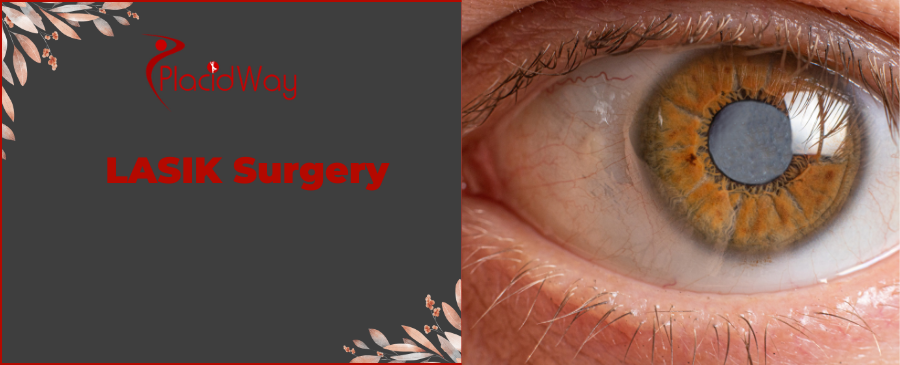
See the World Clearly - Your Guide to LASIK Abroad
Are you tired of the daily hassle of glasses or the ritual of putting in contact lenses? For millions, the dream of waking up with perfect vision feels like a distant, expensive luxury. But what if you could achieve crystal-clear sight without breaking the bank? LASIK (Laser-Assisted in Situ Keratomileusis) eye surgery is a life-changing procedure that corrects vision problems like nearsightedness, farsightedness, and astigmatism. It reshapes the cornea, the clear front part of the eye, allowing light to focus properly on the retina.
Increasingly, patients are looking beyond their borders for this procedure, embracing medical tourism for LASIK surgery. This approach allows you to access world-class surgeons, state-of-the-art technology, and internationally accredited facilities in countries where the cost of care is significantly lower. It’s not just about saving money; it’s about receiving exceptional care while having the opportunity to recover in a new and exciting destination. This guide will walk you through everything you need to know about getting LASIK surgery abroad.
Why is LASIK Cheaper in Other Countries?
It's a common misconception that lower price equals lower quality. In medical tourism, this is rarely the case. The significant price difference for LASIK surgery in countries like Turkey, Mexico, or Thailand is driven by the overall economy. Operational costs, including staff salaries, rent for the clinic space, and administrative expenses, are substantially lower than in the US, UK, or Canada.
Furthermore, many governments actively support and invest in their medical tourism sector, leading to competitive pricing to attract international patients. These clinics often use the exact same FDA-approved or CE-marked laser technology and equipment found in top Western hospitals. The savings are passed directly to you, the patient, making world-class vision correction accessible to a wider audience.
How Does the Cost of LASIK Compare Worldwide?
The financial benefit is one of the most compelling reasons to consider LASIK abroad. While prices can vary based on the specific technology used and the complexity of your prescription, the savings are consistently substantial. To put it in perspective, the money saved on the procedure alone can often cover the entire cost of your travel, accommodation, and even a short vacation.
Here is a general comparison of the average cost of LASIK surgery for both eyes in different countries:
| Country | Average Cost (USD) |
|---|---|
| United States | $4,000 - $6,000 |
| United Kingdom | $3,500 - $5,500 (£2,800 - £4,400) |
| Turkey | $1,200 - $2,500 |
| Mexico | $1,500 - $2,800 |
| Thailand | $1,800 - $3,000 |
Note: These are approximate prices and can vary based on the clinic, surgeon's experience, and the specific type of LASIK technology used.
Which Country is Best for LASIK Eye Surgery?
The "best" country depends on your priorities, including budget, travel distance, and desired destination. Each location offers unique advantages:
- Turkey: Istanbul is a major hub for ophthalmology, known for its ultra-modern clinics, experienced surgeons, and incredibly competitive all-inclusive packages.
- Mexico: Cities like Tijuana and Cancun are convenient for North American patients, providing high-quality care with US-trained doctors at a much lower cost.
- Thailand: Renowned for its hospitality and world-class private hospitals, Thailand offers excellent medical care combined with the opportunity for a tropical vacation.
- South Korea: A global leader in technology and cosmetic procedures, South Korea boasts some of the most advanced ophthalmology clinics in the world.
What are the Different Types of LASIK Surgery?
While the goal is the same, the technology used can differ. Your surgeon will recommend the best option for your unique eyes. Here are the main types:
- Conventional LASIK: This is the standard form of LASIK. It treats a specific prescription (e.g., -3.0 nearsightedness) uniformly across the cornea. It is highly effective for common vision problems.
- Custom Wavefront LASIK: This is a more personalized procedure. It uses advanced 3D mapping technology to create a detailed image of your cornea, identifying even minute imperfections called "higher-order aberrations." The laser then uses this map to deliver a highly precise, individualized treatment, which can result in sharper vision and fewer side effects like glare or halos.
- Bladeless LASIK (Femtosecond LASIK): In traditional LASIK, the surgeon uses a handheld blade called a microkeratome to create the corneal flap. In bladeless LASIK, an ultra-fast femtosecond laser is used to create the flap instead. This method is considered more precise and can reduce the risk of certain complications.
Am I a Good Candidate for LASIK Eye Surgery?
LASIK is safe and effective, but it's not suitable for everyone. A reputable clinic will conduct a comprehensive eye examination to determine your eligibility. Key factors include:
- Age: You must be at least 18 years old, and preferably in your mid-20s, to ensure your eye prescription has stabilized.
- Stable Prescription: Your vision prescription should have remained unchanged for at least 12 months prior to surgery.
- Corneal Thickness: The cornea must be thick enough to safely create the flap and perform the laser reshaping.
- Good Eye Health: You should be free from eye conditions like severe dry eye syndrome, glaucoma, cataracts, or corneal diseases.
- General Health: Certain autoimmune conditions or uncontrolled diabetes may affect the healing process and could disqualify a candidate.
What Happens During the LASIK Procedure?
The entire LASIK procedure is surprisingly fast, typically taking only 10-15 minutes for both eyes. Here’s a simple step-by-step breakdown:
- Numbing Drops: Your eyes will be numbed with anesthetic drops so you won't feel any pain.
- Creating the Flap: The surgeon will create a thin, hinged flap on the surface of your cornea using either a microkeratome (a blade) or a femtosecond laser.
- Reshaping the Cornea: You'll be asked to focus on a target light. The surgeon will then use a computer-guided excimer laser to precisely remove microscopic amounts of corneal tissue, reshaping it to correct your specific prescription.
- Repositioning the Flap: The flap is gently laid back into its original position, where it acts like a natural bandage and begins to heal immediately without the need for stitches.
Is LASIK Surgery Painful?
One of the biggest concerns for patients is the fear of pain. Thanks to the powerful anesthetic drops, you will not feel any pain during the surgery. Patients commonly report feeling a mild pressure sensation on the eye for a few seconds when the corneal flap is being created, but this is not painful. After the surgery, as the numbing drops wear off, it is normal to experience some mild discomfort, itching, or a gritty sensation for a few hours, but this is easily managed with prescribed eye drops.
What is Recovery Like After LASIK?
You'll be instructed to go home and rest with your eyes closed for a few hours immediately after the procedure. You will be given protective eye shields to wear while sleeping for the first few nights to prevent accidental rubbing. Most people are able to return to work and most normal activities the very next day.
Your vision will continue to sharpen and stabilize over the following weeks. It is crucial to follow your surgeon's post-operative instructions, which include:
- Using prescribed antibiotic and anti-inflammatory eye drops.
- Avoiding rubbing your eyes.
- Staying out of swimming pools, hot tubs, and dusty environments for a couple of weeks.
- Attending all follow-up appointments.
Are the Results of LASIK Permanent?
The physical changes made to your cornea by the laser are permanent and will not wear off. The vast majority of patients enjoy clear vision for many years, often for the rest of their lives. However, our eyes are a natural part of our bodies and continue to age. Around the age of 40-45, most people develop a condition called presbyopia, which is a stiffening of the eye's natural lens that makes it difficult to focus on close objects. This happens to everyone, regardless of whether they've had LASIK. When this occurs, you will likely need reading glasses for near tasks, but your distance vision corrected by LASIK should remain clear.
How Do I Choose a Reputable LASIK Clinic Abroad?
Choosing the right clinic is the most important step in your medical tourism journey. Don't let price be your only guide. Focus on quality and safety by looking for:
- Accreditation: Look for clinics accredited by respected international bodies like the Joint Commission International (JCI). This ensures the facility meets the highest global standards for patient care and safety.
- Surgeon's Credentials: Research the surgeon's qualifications, specialization in refractive surgery, and how many LASIK procedures they have performed.
- Technology: Confirm the clinic uses modern, up-to-date laser systems (e.g., femtosecond and excimer lasers) from reputable manufacturers.
- Patient Testimonials: Read reviews and watch testimonials from previous international patients to gauge their experience with the clinic, staff, and results.
What's Included in a LASIK Medical Tourism Package?
To make the process seamless for international patients, many top clinics offer comprehensive packages. This takes the stress out of planning and allows you to focus on your treatment and recovery. While specifics vary, a typical package might include:
- Comprehensive eye exam and consultation.
- The LASIK procedure for both eyes.
- All necessary medications and eye drops.
- The first set of post-operative follow-up appointments.
- Private transfers between the airport, hotel, and clinic.
- A stay in a 4 or 5-star hotel near the clinic.
- Often, a dedicated patient coordinator or translator.
Always clarify exactly what is included in your package before booking to avoid any surprises.
How Long Should I Plan to Stay Abroad for LASIK?
The efficiency of the LASIK process makes it ideal for medical tourism. You don't need to plan for a long, extended stay. A common itinerary looks like this:
- Day 1: Arrive, settle into your hotel, and attend your pre-operative consultation and detailed eye examination.
- Day 2: Have the LASIK procedure. You'll spend a couple of hours at the clinic and then rest at your hotel for the remainder of the day.
- Day 3: Return to the clinic for your first post-operative check-up. The surgeon will examine your eyes and confirm everything is healing as expected. After this, you are usually free to explore the city or fly home.
Some patients choose to stay longer to enjoy a small vacation, but from a medical standpoint, a short trip is all that's required.
Take the Next Step with PlacidWay
Ready to experience the world in high definition at an affordable cost? Your journey to flawless vision is just a click away. Explore top-rated international clinics, compare prices, and get a free, personalized quote for your LASIK surgery with PlacidWay. Let us help you plan a seamless and clear-sighted medical travel experience. Start your transformation today!
Laser Eye Surgery, LASIK Eye Surgery Abroad





.png)
.png)
.png)
.png)

Share this listing